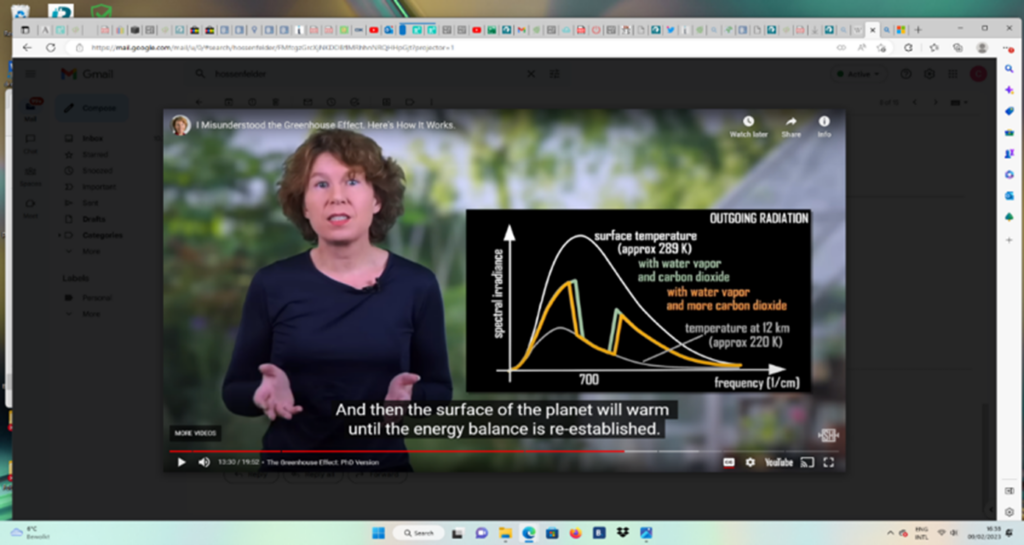Earlier this week a video about climate science appeared on social media by Sabine Hossenfelder1. Dr. Hossenfelder, who did her Ph.D. in Theoretical Physics at Frankfurt, Germany, should be congratulated for popularizing science on the internet2. In this particular video, she discusses the greenhouse effect:
I Misunderstood the Greenhouse Effect. Here’s How It Works. – YouTube

A few items need extra clarification.
An important part of climate science certainly has to do with greenhouse gases and their role in the atmosphere. The fundamental understanding of radiation transfer and the role of atmospheric scattering are therefore essential. The physics underlying this understanding lies in the realm of atomic, molecular and optical (AMO) physics, which happens to be exactly that part of physics that historically played a key role in the development of the quantum theory. Without AMO physics no basic understanding of atmospheric physics!
Sabine Hossenfelder is right that neither nitrogen nor oxygen is a greenhouse gas. But on more than one occasion she suggests that the reason is that nitrogen and oxygen do not ‘’wiggle’’ at infrared frequencies. Both nitrogen and oxygen have vibrational (and rotational) frequencies that are not very different from those of the greenhouse molecules water, carbon dioxide, methane, or nitrous oxide. The key difference is that the highly symmetric homonuclear diatomic molecules nitrogen and oxygen have no electric dipole moments. It is not the wiggles but the wiggling and changing electric dipole moments that allow greenhouse gases to absorb and emit infrared radiation.
In fact, all gas phase molecules transfer energy via collisions that perturb their rovibrational motion. Greenhouse molecules such as water vapor, carbon dioxide, ozone, methane and nitrous oxide have an electric dipole moment unlike homonuclear molecules. Hence, vibrating and rotating greenhouse gas molecules are adept at absorbing and emitting infrared radiation unlike vibrating oxygen and nitrogen molecules.
The video recognizes the importance of saturation which has been studied by a number of scientists3,4. The figure below shows that doubling the CO2 concentration from 400 to 800 ppm, makes a small difference in the top of the atmosphere flux of infrared radiation to space. Integrating over all frequencies yields a forcing of 3 W/m2 which is only about 1% of the average infrared radiation to space. The effect due to doubling CO2 is smaller than suggested by the cartoon used in the video.

Note from the above frequency spectrum that broadening of the CO2-absorption area if the CO2-concentration is increased from 400 ppm to 800 ppm is negligible. Unrealistic CO2-scenarios are needed to realize a broadening as shown in the cartoon in the video.
Finally a word of caution. The correlation between the CO2 concentration in the atmosphere and the warming of Earth’s surface is scanty at best. Even in the recent past (Roman Warm Period, Middle Age Warm Period, Little Ice Age), when CO2 was never an issue, temperature variations were at least as strong as what is observed today since humans started burning fossil fuels. This is not surprising. The heat capacity of the atmosphere is small compared to that of the oceans that make up 70% of Earth’s surface. The real heat engines that dominate heat transfer on the planet are not radiative transfer, but ocean currents, and the gigantic atmospheric heat engine represented by the well-known Hadley cells. The complexity of the climate system is not to be underestimated.
In conclusion, we are pleased that Dr. Hossenfelder’s excellent video confirms that the effects of increasing concentrations of greenhouse gases are very small and highly saturated. This does not support the message that the world is in a climate crisis. We hope that our comment helps improve the public understanding of this important topic.
Kees de Lange, professor emeritus of molecular physics
Guus Berkhout, professor emeritus of geophysics
References
- I Misunderstood the Greenhouse Effect. Here’s How It Works. | RealClearScience
- Sabine Hossenfelder – Wikipedia
- Happer, The Best Schools, 2020, https://www.independent.org/issues/article.asp?id=13480
- A. van Wijngaarden & W. Happer, 2020, “Dependence of Earth’s Thermal Radiation on Five Most Abundant Greenhouse Gases”, Atmospheric and Oceanic Physics arXiv: 2006.03098.
